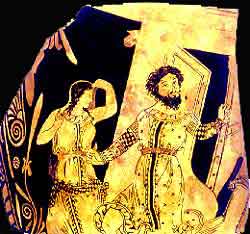Ancient Actors and Chorus Members were masked. Consequently gesture and body language were extremely important. In fact the actors and chorus could sign the meaning of the words (cheironomia).
Since real tears could not be seen under the masks, weeping was conveyed by turning the face away or down and by veiling the head. Postures of supplication and prayer were used a lot. When praying, the actor would extend both arms outward, with his palms turned up if he were praying to the gods of the heaves and his palms turned down if he were praying to the gods of the earth or the underworld. Suppliants knelt and embraced the knees of the person they were supplicating. They also reached with one hand to touch the beard or chin of the person from whom they were asking help or protection.
The tragedy are filled with lamentations. Gestures of lamentation include, ripping the cheeks (not liteally possible in a mask, pulling the hair, beating the body--all of these are lavishly described in The Persians.
They had three methods of delivery: spoken language in dialogue, chant in long speeches, and songs. All choruses were sung and danced. The singing roles in The Persians are the Chorus and Xerxes.

women lamentating as Polyxena is sacrificed

tragic actprs in an unknown play

an actor with the costume and mask of a warrior king